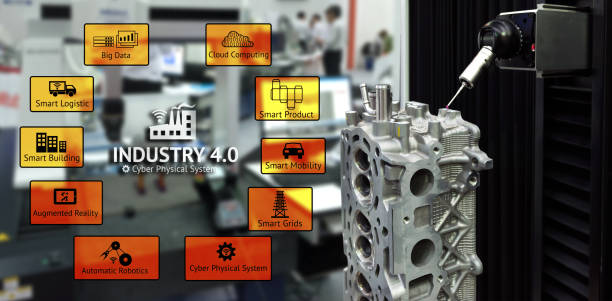How To Build A Scalable IoT Solution For Industrial Automation

Imagine a factory where the machines can talk to each other and share data. A factory where the machines can monitor themselves and predict potential problems before they occur. A factory where the machines can adapt to changes in demand and production.
This is the future of industrial automation, and it is powered by the Internet of Things (IoT).
In this very article, we will take a look at How to build a scalable IoT solution for industrial automation. Just read it down, it will not waste your time at all and do not skip any part.
What is an IoT solution for industrial automation?

Databricks says an IoT solution for industrial automation is a network of connected devices that collect and share data to improve the efficiency, productivity, and safety of industrial processes.
IoT solutions for industrial automation can be used to monitor and control a wide range of devices and processes, including:
- Manufacturing equipment
- Robots and cobots
- HVAC systems
- Energy management systems
- Security systems
Benefits of using IoT solutions for industrial automation
There are many benefits to using IoT solutions for industrial automation, including:
- Increased efficiency: IoT solutions can help to improve the efficiency of industrial processes by automating tasks, reducing waste, and optimizing production.
- Increased productivity: IoT solutions can help to increase the productivity of industrial processes by providing real-time data and insights that can be used to improve decision-making.
- Reduced costs: IoT solutions can help to reduce the costs of industrial processes by reducing energy consumption, maintenance costs, and downtime.
- Improved safety: IoT solutions can help to improve the safety of industrial processes by monitoring for potential hazards and predicting potential problems early on.
How to build a scalable IoT solution for industrial automation
Iotforall.com stated that when building a scalable IoT solution for industrial automation, there are a few key things to keep in mind:
- Choose the right hardware: The hardware that you choose will depend on the specific needs of your IoT solution. Factors to consider include the types of devices that you will be connecting, the data that you need to collect, and the environmental conditions in which the devices will be operating.
- Choose the right software platform: The software platform that you choose will provide the foundation for your IoT solution. It will be responsible for collecting and storing data, managing devices, and providing insights and analytics.
- Design for scalability: When designing your IoT solution, it is important to consider scalability from the start. This means choosing components and architectures that can be easily scaled up or down as needed.
Here are some additional tips for building a scalable IoT solution for industrial automation:
- Start small and scale up gradually. It is better to start small and scale up gradually than to try to build a large-scale solution all at once. This will allow you to test your solution and identify any potential problems early on.
- Use a modular architecture. A modular architecture will make it easier to add or remove components from your solution as needed.
- Use cloud-based services. Cloud-based services can provide scalability and reliability for your IoT solution.
- Implement security measures. It is important to implement security measures to protect your IoT solution from cyber attacks.
FAQs about How to build a scalable IoT solution for industrial automation.
Okay guys, now let us look into building a scalable IoT solution for industrial automation.
What are the different types of IoT devices that can be used for industrial automation?
There are a wide variety of IoT devices that can be used for industrial automation, including:
- Sensors: Sensors can be used to collect data about a variety of factors, such as temperature, pressure, humidity, and vibration.
- Actuators: Actuators can be used to control devices, such as valves, motors, and robots.
- Controllers: Controllers can be used to process data from sensors and to send commands to actuators.
- Communication devices: Communication devices allow IoT devices to connect to a network and to communicate with each other.
What are the different types of IoT software platforms that can be used for industrial automation?
There are a number of different IoT software platforms that can be used for industrial automation. Some popular platforms include:
- Amazon Web Services (AWS) IoT Core
- Microsoft Azure IoT Hub
- Google Cloud IoT Core
- IBM Watson IoT Platform
- SAP Leonardo IoT
What are some of the challenges of building and deploying IoT solutions for industrial automation?
Some of the challenges of building and deploying IoT solutions for industrial automation include:
- Security: IoT solutions are vulnerable to cyber attacks, so it is important to implement robust security measures.
- Complexity: IoT solutions can be complex to design, implement, and manage.
- Integration: IoT solutions need to be integrated with existing industrial systems and processes.
- Cost: The cost of building and deploying IoT solutions can be significant.
How can I overcome the challenges of building and deploying IoT solutions for industrial automation?
Here are some tips for overcoming the challenges of building and deploying IoT solutions for industrial automation:
- Security: Implement a layered security approach that includes encryption, authentication, and authorization.
- Complexity: Break down the project into smaller, more manageable tasks. Use a modular architecture to make it easier to add or remove components as needed.
- Integration: Use an IoT software platform that provides integration capabilities. Work with a partner who has experience in integrating IoT solutions with industrial systems.
- Cost: Start small and scale up gradually. Use cloud-based services to reduce the costs of hardware and software.
What are some of the best practices for building and deploying IoT solutions for industrial automation?
Here are some best practices for building and deploying IoT solutions for industrial automation:
- Start with a clear understanding of your goals and requirements. What do you want to achieve with your IoT solution? What data do you need to collect? What devices do you need to connect?
- Choose the right hardware and software platform. Consider your specific needs and requirements when choosing hardware and software.
- Design for scalability and security. Make sure that your IoT solution can be scaled up or down as needed. Implement robust security measures to protect your solution from cyber attacks.
- Test and monitor your solution. Test your IoT solution thoroughly before deploying it in production. Monitor your solution after deployment to identify and address any potential problems.
- Work with a partner who has experience in IoT for industrial automation. A partner can help you to design, implement, and deploy your IoT solution.
Conclusion
IoT solutions for industrial automation have the potential to revolutionize the way that manufacturing is done. By following the tips above, you can build a scalable IoT solution that will help you to improve the efficiency, productivity, and safety of your industrial processes.
I believe that IoT solutions for industrial automation have the potential to make the world a better place.
By making manufacturing more efficient and productive, IoT solutions can help to lower the cost of goods and services. Additionally, by improving the safety of industrial processes, IoT solutions can help to protect workers and the environment.
If you are involved in the manufacturing industry, I encourage you to consider using IoT solutions to improve your business. IoT solutions have the potential to give you a competitive advantage and to help you to achieve your business goals.
Thanks for reading. If you have any question about how to build a scalable IoT solution for industrial automation, do not hesitate to drop it in comment section below.








